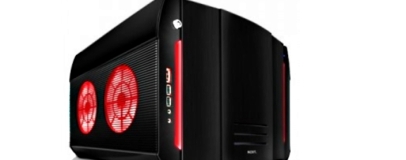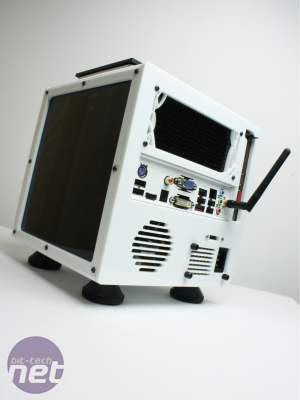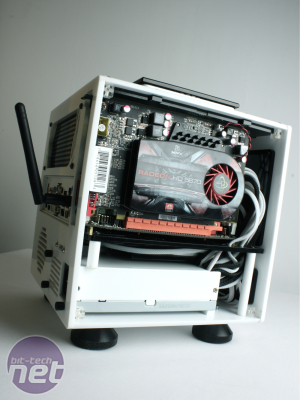
Watercooling and Advice
Bit-tech: Do you think it’s easier to build a small PC from scratch or to use
an existing case as a blueprint?
Mike Krysztofiak: Scratch builds and case mods are totally different worlds. When you make a scratch build, you can do anything you want, any design you can image, any size, any shape. Making a case mod you are restricted to the size and shape of the case. There is always something that you can expand, but in most cases it stays in the shape of the chassis. Which one is easier? I think case mod.
Scratch build is always harder to build cause you need to design it from the beginning and foresee any issues you may have with it. Also, making all pieces by yourself is harder, either it's acrylic, aluminium or wood. But then this all makes scratch builds more interesting and fun!
Craig Brugger:Having used existing cases for my first three mods, and now building from scratch with OSIDIAS, I’d have to say it’s easier to roll your own assuming you’ve got competent modding skills. You’ve got complete creative control and don’t have to workaround the mass-market limitations of a manufacturer. Not to mention, there is a huge amount of satisfaction to be gained in designing a case from the ground up.
One of the greatest tools available to aspiring modders comes in the form of a copy SketchUp, and the SketchUp Component Collection at http://scc.jezmckean.com/home. This allows you to work on parts placement and a case design before you start to build. Seeing components visualized in a 3D environment can help solidify great ideas, and weed out bad ones. Many times I’ve had a great idea in my head, only to realize it wasn’t feasible once seen on the screen.
I would advise that new or inexperienced modders tackle modifying an existing case before attempting a scratch build. There are certain skills that are only honed by practice. Although I have seem some stellar first time scratch builds, I’ve seen many more end in frustration when the challenge becomes greater than anticipated. Also, unless sourcing used construction materials, scratch builds usually cost much more to build. Whether building from scratch, or modifying something existing, keep expectations in check, and as I’ve
said before, be willing to adapt.


Minime by Oliver Woodings
Bit-tech:Do you think water cooling is useful in a small case that uses how components?
Mike Krysztofiak: In very small builds, for example my Nano Tower, it was necessary to use watercooling. I minimised structures main issue always will be heat - that is why it needs the best cooling solution there is. In Nano Tower there was a very poor air circulation, so had to "route" the heat outside other way - through the tubing of watercooling. Also I had to design all the hardware to be positioned the way it will still let the hot air go up. Unless you have plenty of space inside and empty "chamber" that can easily shift the hot air outside, water cooling is not only a visual feast, but also a necessity.
Craig Brugger:Watercooling is definitely useful in a SFF case, but there are a few catches. Keep in mind that most of the water-cooling components that can be made to work in a true SFF rig, don’t typically offer significantly improved performance over their aircooled counterparts. However, what they do offer, is flexibility in placement and case design. You aren’t required to make room for a heatsink and fan on the CPU. Simply add a waterblock and move the radiator to wherever you wish, assuming adequate airflow. If you can handle the added expense, and don’t mind the increased maintenance, water can really help showcase innovative design.
Bit-tech:What advice would you give to someone embarking on a project that involves making a small but powerful PC?
Mike Krysztofiak: Do you planning! Take time, plan everything, every single part of the case, position of the hardware, consider the air circulation inside, what cooling needs to be used. Choose your hardware parts carefully and make sure you know all their dimensions, but also every piece of the case - thickness of the panels or inside structure makes difference too! Also have in mind that at the end you need to route all the wires and cables, which will also take space inside of your brilliant build! Last thing - take time, don't rush things up and enjoy yourself!
Craig Brugger: In order to build a solid SFF PC, you’ve got to be willing to think creatively. Everything that can be a potential problem in a full size tower, gets amplified when the scale comes down. Hot components, closer together, with limited airflow, can provide a definite challenge. However, the rewards are well worth it. There is a much greater sense of accomplishment when that challenge is met.
ATX case design has stagnated somewhat, and there are only so many ways you can mod a Lian Li, or TJ07. Motherboard manufacturers are putting out some powerful ITX, and mATX options, and the performance gap between those boards and their ATX siblings has narrowed quite a bit. You don’t need to compromise when choosing components for your build, but you have to allow those parts to perform at their best.
If you’ve decided to build upon an existing case, and are lacking in a little in your SketchUp skills, then gather your components and try holding them in different positions in the chassis. Visualize things like potential airflow and wire management. Look at it from an engineers point of view. Will you have to fabricate brackets or cut holes? Can that be done without compromising the integrity of the case? Can it be maintained after built? How long would it take to do a simple hard drive swap? These are just a few of the questions you need to ask yourself when contemplating a SFF mod.
When building from scratch, do yourself a favor, and try to learn using the 3D design program of your choosing. You can usually draw up a concept on a couple of days, but you could easily spend weeks or even months fine tuning. The time and effort spent up front will save you expense and frustration later.
No matter what you do, take the time to do it right, and you’ll have results to be proud of. Even more so when you realize that you just walked in to your next LAN with a shoebox sized PC under your arm... Everyone else will be scrambling for the closest parking spot, and then lugging their monstrosities in to the building, while you’re already set up and gaming. When it comes to SFF computing, it’s one time where bigger, certainly doesn’t mean better.
That's all folks. A huge thanks to Craig for his time and invaluable advice and do share your thoughts on SFF PCs in the comments.

MSI MPG Velox 100R Chassis Review
October 14 2021 | 15:04








Want to comment? Please log in.